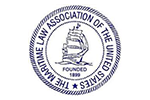Wrongful Death Attorneys
Suing Ronald Reagan . . . My First Maritime Case
By John Merriam
“Sue the government for shutting down the old Marine Hospital,” my new boss ordered. He was referring to the U.S. Public Health Service Hospital on Seattle’s Beacon Hill, now the headquarters for Amazon.com. We were in my office at his law firm, on the top floor of the Seattle Trade Center, overlooking Elliott Bay.
“OK,” I eagerly replied. “What legal theory should we use for a cause of action against the government?” I was a brand-new lawyer, having taken the bar exam a week earlier. Actually, I wasn’t even a lawyer yet. Until the results from that summer’s exam were announced and I was sworn in as a member of the bar, I was a lowly (‘Admission to Practice’) Rule 9 Intern. My boss was a sole practitioner, until he hired me, with a personal injury practice heavily weighted toward merchant seamen injured on the job.
“I don’t know—think of something. Seamen have used the Marine Hospitals for 200 years. Reagan can’t just shut them down.” My boss left my desk and went into his own office. He closed his door, leaving me to stare out the window and wonder how to start this project. It was August 1982.
The stately brown building atop Beacon Hill was built in 1932 as a U.S. Public Health Service Hospital, long after the Marine Hospitals were absorbed by the USPHS in 1902. It provided free medical care to military dependents and American Indians, among others, in addition to merchant seamen and commercial fishermen. It was scheduled to close its doors for good the following month, on September 30, 1982. Starting a year earlier, on October 1, 1981, seamen and others were gradually squeezed out of free medical care. Only those who remained inpatient retained their entitlement, for a maximum of one year. Seamen receiving treatment on an outpatient basis were cut off immediately. In the Budget Act of 1981, passed by Congress on August 13th, seamen were given a mere seven weeks’ notice that their 200-year entitlement to medical attention was to end.
Ronald Reagan was on a roll during his first year in office in 1981. His poll numbers were so high that it took Democrats in Congress quite a while to grow a backbone and slow him down. In July 1981, a month before the fatal Budget Act was enacted, he got Congress to pass the then-largest tax cut in U.S. history. Reagan also requested and got an enormous increase in military expenditures. At the same time that the new President was lowering tax rates (mostly for the wealthy) and giving billions more to the Pentagon, he also promised to balance the budget by cutting so-called entitlement programs. Most of the budget cuts were to education, housing, food stamps, welfare and social service agencies, and to other programs designed to help the neediest Americans. My take on “Reaganomics” was that the President was taking money away from poor people and giving it to his rich pals and the Pentagon. Congress stopped some of Reagan’s proposed budget cuts, but there wasn’t much organized support for the Public Health Hospitals. Reagan was immensely popular and used television addresses to the public to sell his agenda, which caused hesitant Congressmen to cave in. Meanwhile, during the first year of Reagan’s presidency, the national debt reached $1 trillion, the then-largest amount of indebtedness in American history. During Reagan’s eight years in office, the nation’s debt tripled. The poverty rate rose, even as the benefits of economic growth flowed to those in upper income brackets.
Congress established the Marine Hospitals in 1798. I couldn’t remember anything from law school about how to stop the President and Congress from using budget cuts to cut off programs that Congress had created in the first place. I ran up a huge hot water bill in my house while standing in the shower trying to think of a legal theory that would justify suing the government for closing the now-USPHS Hospitals. Congress is immune from lawsuits—they can’t be sued for what they do. The actual shut-down of the hospitals would be performed by the executive branch of the government, headed by President Reagan who signed the Budget Act into law, and it was the executive branch I would have to sue. I hit the law books in a desperate search for support of the theories I came up with, most of which were far-fetched at best.
The Marine Hospitals were paid for by a “hospital tax”, a head tax on seamen coming into the U.S. from 1798 to 1884 and later—until about 1907—by a “tonnage tax” on ships. At some point proceeds from those taxes were paid into the general fund instead of to the hospitals directly and, starting in 1905, the Marine Hospitals were supported by general government revenue. By then, the Marine Hospitals were more properly called Public Health and Marine Hospital Service of the United States (now known as the U.S.P.H.S.), when that agency was created in 1902.
Under the judge-made general maritime law, which is older than English common law, shipowners are legally obligated to provide medical care to seamen injured or taken ill while in the service of the ship. The government assumed that obligation in 1798 when it created the Marine Hospitals, and tried to shed it in 1981 with passage of the Budget Act. Congress shouldn’t be allowed to dodge this obligation, I reasoned—certainly not to those depending on it at the time of their illness or injury—when both seamen and shipowners relied on the government to take the place of the shipowners in providing free medical care. That would be my main legal theory, that the government had assumed the responsibilities of shipowners. While Congress could certainly disclaim this responsibility for seamen injured or taken ill in the future, it would offend the legal principle of equity to do so retroactively, for those already relying on the government to provide medical care.
However, there was a big problem with this argument. In 1949, the U.S. Supreme Court ruled that shipowners were only obligated to provide injured seamen with maintenance and cure until the seamen reached “maximum cure”. Farrell v. United States, 336 U.S. 511. Maintenance and cure is the seaman’s substitute for workers’ compensation. ‘Maintenance’ is a barebones living stipend during the seaman’s medical treatment; ‘cure’ is the payment of medical bills. “Maximum cure” means that a seaman is as good as he is going to get. When he stops improving, according to the Farrell decision, the shipowner can cut off his benefits. For example, a seaman’s leg is amputated, the result of walking down a defective gangway. He’s entitled to maintenance and cure until his stump heals and he’s fitted with an artificial leg. After that, he’s cut off. If his stump later transforms into a different shape and the seaman needs a new artificial leg . . . tough luck! The problem was that most if not all seamen depending on ongoing ‘cure’ from the Public Health Hospital were at maximum cure—some having been injured as long ago as World War II. Their problems were chronic and usually incurable. I had to get around the Farrell decision. This time I dove into the general maritime law, starting with the ancient sea codes, looking for support.
Farrell v. United States was a 5-4 decision. Some of the four dissenters, led by Justice William O. Douglas, believed that seamen injured in the service of the ship should be entitled to maintenance and cure for life. At least one of the sea codes—some of which were written in the Middle Ages—seemed to support that position, at least when it came to seamen injured when defending their ship from “sea rovers” (pirates). But even a well-reasoned and eloquent dissent by four Justices on the Supreme Court is like having the second-best hand in a game of poker. The Farrell majority’s decision was the law of the land and I was stuck with it. I read the opinion for the fourth or fifth time.
Farrell, the merchant seaman involved in the Supreme Court decision, got hurt during World War II while on shore leave from a U.S. freighter in Sicily. His injuries were permanent and incurable. The shipping company paid him a few bucks per day as maintenance and he received free treatment at a Public Health Hospital. The question presented to the Supreme Court was how long the shipowner had to keep paying maintenance. No one cared about ‘cure’ because, at the time, it would be provided for life—gratis—by the Public Health Hospitals. Although the decision states that the obligation to furnish maintenance and cure ceases at maximum cure, the case really involved a dispute over maintenance only. Anything written about ‘cure’ was dictum—not part of the ruling—and not legally binding as precedent. So, if the shipowners’ obligation to provide ‘cure’, as opposed to maintenance, didn’t necessarily end at the point of maximum cure, how far did it extend?
The U.S. Constitution was drafted in 1787 and ratified in 1789. Article III, section 2 of the Constitution gives judges the authority to rule on matters pertaining to the maritime law—supplementing acts passed by Congress purporting to change that law. It was then—or perhaps earlier, when the Declaration of Independence was signed in 1776—that American maritime law parted ways with legal precedent from English Admiralty courts. The first decision defining the doctrine of maintenance and cure in the ‘new’ United States did not come until 1823, when Justice Story wrote Harden v. Gordon, 11 Fed. Cas. 480, No. 6047 (CC Maine 1823), stating that seamen were the favorites of admiralty courts and should be given every consideration in matters pertaining to maintenance and cure. By 1823 the Marine Hospitals had been established for 25 years and ‘cure’ for life was assumed as a given by Justice Story in the Harden decision. How long then was the shipowners’ obligation to provide cure to seamen between 1789 and 1798, when the Marine Hospitals were established? In other words, how long would shipowners have been required to take care of seamen injured in the service of their ships, had their responsibilities not shifted to the government? No one could say for sure because there were no reported cases on the issue in U.S. courts before 1798. I started gathering caselaw and other material to support an argument that seamen in the U.S. were owed lifelong medical care from shipowners before 1798, when the government took over.
After coming up with legal authority and argument that would prevent, I hoped, getting me laughed out of court—or worse, get me fined for filing a frivolous lawsuit—I started looking around to see exactly whom I was representing, and to try to get some financial support for the lawsuit.
David Loud, a patient advocate working in the Public Health Hospital on Beacon Hill, was very helpful in supplying information, as well as connecting me with patients in dire straits who would make good representative plaintiffs. He told me that seamen comprised about 20% of the patient population in the Seattle hospital, while nationwide at USPHS Hospitals the percentage of seamen was about 40%. Using these figures, I estimated (actually, it was more of a guess) that 5,000 permanently disabled seamen would be cut off from medical care were the USPHS hospitals to close. That was more than enough to bring the lawsuit as a class action.
Next I tried to drum up some financial support. None of the maritime unions that I contacted were interested. There had been an earlier, unsuccessful effort to prevent closure of the USPHS Hospitals, involving some of the unions, David Loud and many other groups and individuals. I tried to convince union port agents and their lawyers that I was bringing a case based upon different legal theories. It didn’t work. Everyone I talked to at various unions balked, feeling they were under siege from Reagan’s assaults on organized labor. Other potential allies told me my effort was doomed. On top of the general pessimism, I sensed an underlying distrust of lawyers—like I just wanted to get paid big bucks, by the hour, when everybody knew I couldn’t win.
When I told my new boss that no one would fund the lawsuit, he told me to file it anyway. “We’ve got to help these guys,” he said. “Look at Morgan Jones.” Morgan was a client whose case my boss had just settled out of court, and who would become the lead plaintiff in our class action against the government. “He broke his ankle on a gangway in April last year and got osteomyelitis. He was in the Marine Hospital until August, just before this new law was passed. His doctors didn’t decide to amputate his lower leg until after the cut-off date last September 30th. Because he was outpatient on that one day, he’s all of a sudden ineligible for amputation by his doctors at the Hospital. That’s not right!” My boss paused and fixed his gaze on a Sea-Land ship docking at Pier 5, no doubt wondering if anyone had been hurt on the voyage south from Anchorage. “Anyway,” he continued, “we’ll get awarded attorney fees when we win. This will be good practice for you.” It looked like we’d be suing the government pro bono.
On August 18, 1982, 16 days after I was hired—and after a crash course in maritime and constitutional law more intense than studying for the bar exam—I filed a class action lawsuit on behalf of approximately 5,000 permanently disabled seamen in U.S. District Court for the Western District of Washington at Seattle. I named as defendants President Reagan, Secretary of the Dept. of Health and Human Services Richard Schweiker, Surgeon General C. Everett Koop, and Director of the Seattle USPHS Hospital Richard Tomkins. I thought that getting the clerk of the federal court to sign a Summons to Ronald Reagan, ordering him to answer the lawsuit, was a pretty cool way to start my legal career.
In the lawsuit I claimed that the government was prevented from shutting down the USPHS Hospitals on grounds of constitutional guarantees of due process and equal protection of the law, contract law or quasi-contract based upon the government stepping into the shoes of shipowners, violation of the separation of powers doctrine based upon Congress taking away protection given to seamen by the courts, and upon grounds of equity—the English common law notion of ‘fairness’.
The case was assigned to Judge Donald Voorhees. Appearing for the government was a William McIntyre, an Assistant U.S. Attorney with the Dept. of Health and Human Services based in Oregon. The government lawyer immediately filed a motion for summary judgment, requesting that the case get thrown out of court. Other than that, however, Bill McIntyre didn’t seem to fight very hard. I don’t know if his lackluster effort was the result of: 1) He figured I was tilting at windmills and was confident I would lose; 2) He didn’t like Ronald Reagan; or 3) He was worried about his own pension getting slashed in the next round of budget cuts. Bill didn’t shoot an arrow at my Achilles’ heel, never once arguing that the doctrine of ‘maximum cure’ defeated my main legal argument that seamen were entitled to ‘cure’ for life. That is, even if the government had assumed the obligation of shipowners to provide seamen with maintenance and cure, that obligation stopped long ago for most of my clients, all of whom were permanently not-fit-for duty.
At oral argument on the government’s motion for summary judgment and my motion for class certification, Judge Vorhees granted both motions. The judge was sympathetic to the seamen’s plight but dismissed the lawsuit, basically ruling that Congress can do anything it wants. He also granted my motion to certify the class of plaintiffs, which meant that all 5,000 seamen were thrown out of court, not just my immediate clients that I’d named as representatives of the class.
Judge Vorhees denied my motion for reconsideration and I appealed to the 9th U.S. Circuit Court of Appeals, based in San Francisco.
I lost again. The Ninth Circuit basically said ‘what Congress giveth, Congress can take away’. The panel of three appellate judges shot down my arguments one by one. They ruled that seamen are not a ‘suspect class’—like race, religion or national origin—deserving of special protection. Seamen were not denied ‘equal access’ to a basic right—free medical care. The hospital and tonnage taxes did not create a contract or quasi-contract that barred the government from cutting off medical care. Article III, sec. 2 of the Constitution did not limit Congress’ authority to change the maritime law. The panel wouldn’t address equity, however, stating that the question of equitable relief was not yet “ripe”. In response to my claim that the seamen were without recourse to pursue shipowners after the USPHS Hospitals closed, the judges wrote that the seamen could still bring individual lawsuits against shipowners to determine their entitlements to medical attention. Even for long-ago injuries, the panel magnanimously ruled that the doctrine of laches (inexcusable delay) didn’t necessarily bar suits against shipowners because a change in the law gave seamen a good excuse for delay.
I took issue with that part of the Ninth Circuit’s decision about equitable relief, or rather the unavailability thereof. Most of the seamen with serious conditions had already brought claims against their employers before the USPHS Hospitals closed and either settled their cases or gotten verdicts from trial that didn’t include future medical expenses. The doctrine of res judicata (finality) prevented seamen from reopening those cases. Most of those who didn’t bring claims were taken ill or injured while working for shipping companies that long ago went out of business or filed for bankruptcy.
In late 1984, just after the decision was published by the Ninth Circuit, I filed a Petition for Rehearing and Suggestion for Rehearing En Banc, asking that all the appellate judges reconsider the case. My petition was denied. After that I filed a Petition for Writ of Certiorari, asking the U.S. Supreme Court to review the case. That petition was denied in 1985. The seamen lost. The case is reported at Jones v. Reagan, 748 F.2d 1331 (9th Cir. 1984), cert. denied, 472 U.S. 1029 (1985).
Some good might have come out of the case. The Court of Appeals gave seamen a green light to go after shipowners for their medical expenses years, sometime decades, after they were hurt or taken ill. The seamen were permanently disabled and all, probably, were at maximum cure. Although “maximum cure” is never mentioned in the appellate decision, it is almost axiomatic that maximum cure did not prevent “a class of merchant seamen who have been declared permanently not fit for duty” (748 F.2d at 1334) from demanding that medical attention continue to be paid for by the shipowners. I’ve been using this theory in applicable cases for the past 25 years. The cases all settled and never resulted in a reported court decision, so the entitlement to lifetime cure for permanent maladies is still an open question, at least in this part of the country. The First Circuit Court of Appeals (for federal courts in New England and Puerto Rico) ruled that a seaman with multiple sclerosis was not entitled to free medical attention beyond maximum cure. Whitman v. Miles, 287 F.3d 68 (1st Cir. 2004). The First Circuit decision failed to mention the Jones v. Reagan case and is not binding precedent outside the boundaries of that federal circuit. Within the Ninth Circuit and the state courts of Washington, I’ll keep on pushing for lifetime cure to seamen with incurable conditions.
The USPHS Hospital on Beacon Hill closed its doors for good on September 30, 1982. The building then became Pacific Medical Center, a public development authority serving low-income patients. The building closed as a hospital in 1987 but continued to house Pacific Medical Center in a limited capacity. Amazon moved in during 1999. The old hospital is now called the Amazon Pac-Med Building.
John Merriam was a merchant seaman from 1970 to 1982, while working his way through college and law school. He is now a sole practitioner at Fishermen’s Terminal in Seattle, representing seamen on wage and injury claims.













